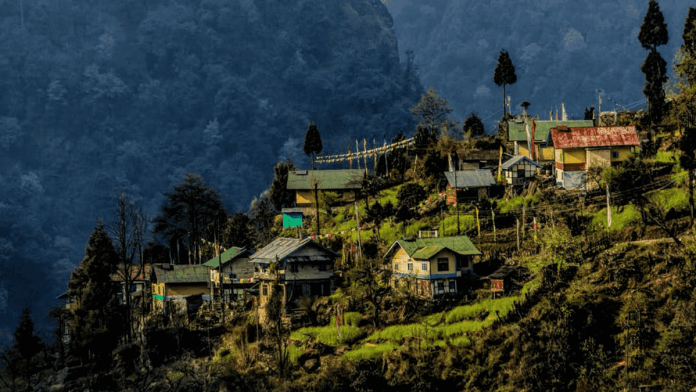In the previous discourse, we studied about the cultural, geographical and political tinge of Sikkim. Haven’t checked it out yet? You can click here and go through it – Know your state ‘Sikkim’ (Part 1). Now, here we will be discussing the history, environment, and economic aspects of Sikkim.
What is the GDP of Sikkim? What are the environmental aspects of Sikkim?
So let’s get started exploring further about the history of Sikkim.
Table of Contents
HISTORY Sikkim GK Notes:
Sikkim’s history is known very little prior to the 17th century. The state derived its name from the Limbu words Suhim that means ‘new house’. Sikkim was a Buddhist kingdom under the Namgyal- Chogyal dynasty from 1642 to 1975.
- The first known people to occupy Sikkim are the Lepcha.
- The Bhutia began entering the Sikkim region from Tibet in the 14th century and established their kingdom in Sikkim area in 1642.
- Phuntsog Namgyal was the first temporal and spiritual king who came from the Bhutia community.
- Sikkim fought a series of territorial wars with both Bhutan and Nepal in the mid-18th century, and Nepal subsequently came to occupy parts of western Sikkim and the Tarai region to the south.
- In 1816 these territories were restored to Sikkim by the British in return for its support during the Anglo-Nepalese War.
- The treaty established Sikkim as a princely state under British dominance, and the British were given rights of free trade and road making through Sikkim to Tibet.
- A British political officer was subsequently appointed to assist the chogyal kingdom for the administration of Sikkim’s domestic and foreign affairs.
- After India’s independence, the Indo-Sikkimese Treaty made Sikkim part of the Indian Territory in 1950 with India assuming responsibility for the external relations, defence, and strategic communications of Sikkim.
- The terms of the treaty also included increased popular participation in government, and five general elections based on adult suffrage were held between 1952 and 1974.
- Sikkim became the 22nd state of India on May 16, 1975.
Now, let’s talk about the environmental aspects of Sikkim.
ENVIRONMENT Sikkim GK Notes:
Sikkim is bestowed with majestic undulating terrains, snow-clad mountains, beautiful hills and valleys, crystal clear waterfalls, springs and lakes, rivers, streams and steep. Forest land of the state is sprinkled with varied forms of flora and fauna.
- State lies in the Eastern Himalayas which is a biodiversity hotspot. Forests in Sikkim harbours a host of endemic flora, rare and endangered species of plants and animals, high value medicinal plants etc.
- There are mainly five forest types in Sikkim namely Sub Tropical, Moist Mixed Deciduous, Wet Temperate, Conifer and Sub-Alpine forest.
- The state has 30.77% of the forest as protected area comprising of seven wildlife sanctuaries and one national park
- Khangchendzonga National Park is the only National Park in the state and was inscribed as India’s first “Mixed World Heritage Site” on UNESCO World Heritage List. It is considered one of the widest altitudinal ranges of any protected area worldwide.
- The people of Sikkim are environmentally aware for the conservation of its natural resources and sustainable use of forest resources.
- Sikkim has two main rivers, the Teesta and the Rangeet, both of which are formed at high altitudes and flow in a generally southern direction.
- National Hydro Power Corporation (NHPC) has 28 dams planned on the Teesta and its tributaries in the Sikkim- Darjeeling Himalaya.
- Rangit Dam is the headwork of the Rangit Hydroelectric Power Project Stage III and is a run-of-the-river power project on the Ranjit River.
It’s time to talk about the economy of the state.
ECONOMY Sikkim GK Notes:
Sikkim’s economy is the third smallest GDP among India’s states. Its economy is based primarily on agriculture and includes more than half of the working population. Sikkim produces more cardamom than any other Indian state and is home to the largest cultivated area of cardamom. Copper, lead, and zinc are mined in Sikkim. The state also has deposits of other minerals, including coal, graphite, and limestone. Sikkim’s mineral resources are commercially utilised only a fraction.
GDP: ₹0.222 lakh crore
GDP Rank: 30th
GDP per capita: ₹ 1,436,313
Unemployment: 4.3% (2017-18)
EDUCATION Sikkim GK Notes:
The Government of Sikkim has accorded highest priority to the education sector by providing an outlay of almost 20% of the State’s budget and records have shown that much progress has been achieved, manifesting in remarkable performances by the students. Primary and secondary education in Sikkim is offered free of charge through hundreds of government schools. There are many private schools operating within the state. Higher education is available at a number of institutions, including the Sikkim Manipal University of Health, Medical and Technological Sciences in Gangtok.
SPORTS:
Sho is a traditional game of Sikkim, also called SHOH and is very popular among worker class. This dice game Shoh is played using two dice which are shaken in a wooden bowl which is then upturned on a circular leather ‘plate’ with a loud thump and a shout. Sikkim being a small state located in the foothills of the great Himalayas is popular for its adventure sports like rafting, trekking, yak riding and mountaineering besides its scenic beauty.
Here are some more interesting facts about SIKKIM:
- Kangchenjunga is the third highest mountain in the world. It is situated between Nepal and Sikkim in India.
- The numerous natural hot springs of Sikkim acts as a natural spa. Some of the most famous natural hot springs are Yumthang Hot Spring, Yume Samdong hot spring, Taram hot spring, Reshi hot spring, Borong hot spring and Ralong hot spring.
- Ecclesiastical Department is a unique department which caters to the need for the proper functioning of more than two hundred temples, monasteries, mosques, churches, and gurudwaras situated all over the state of Sikkim.
- The Singshore Bridge in Pelling, Sikkim is the 2nd highest suspension bridge in Asia.
- Nathula Pass in Sikkim was once a part of the famous Silk Route until 1962. The pass is also an optional route from India to the Kailash Mansarovar in Tibet.
- Sikkim has become the first Indian State to implement organic farming and is called India’s first Organic State.
Therefore, this was all the chief necessitate information about SIKKIM that will help in your preparation for competitive exams like SSC CGL, CDS, Civil Services and NDA etc.
In the next blog, we would be discussing some interesting facts and trivia about the state of Tamil Nadu. Click here for Know your State – ‘Tamil Nadu’.
THANK YOU




